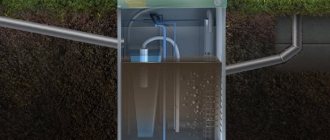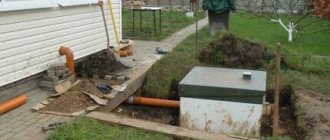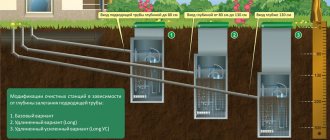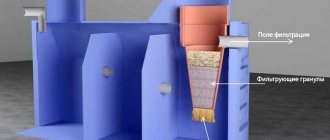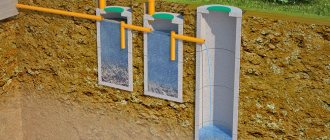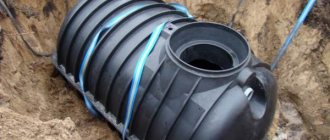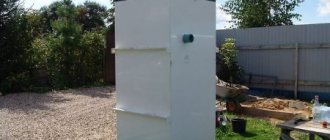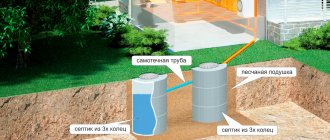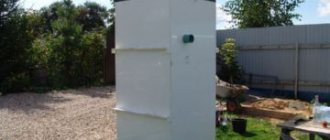Today we will talk about the correct connection of the Topas septic tank control unit. There are many septic tanks, and Topas is the most famous among all. Given the popularity of the control unit, it couldn't be easier here. But despite its simplicity, you need to understand how it works and where it connects. Many Topas owners try to independently maintain their Topas septic tank, as well as repair it, but it is not always possible to do it correctly. For example, how to connect the Topas control unit?
Design and principle of operation of Topas septic tanks
The range of domestic septic tanks Topas is extensive. There are both inexpensive options with low productivity for a summer residence, as well as powerful stations for large cottages and even villages. Externally, they all look like a box 2.5–3.1 meters high, closed on top with a lid.
The body of this VOC is made of composite polypropylene, which is resistant to the aggressive environment inside and temperature changes outside. It is, of course, not as durable and frost-resistant as clinker tiles for facades, but in winter this plastic will definitely not crack in the ground. Moreover, the temperature inside the operating station is always naturally maintained in the positive zone.
Topas station design diagram
A - Receiving chamber
1 - Input of drains
- 2 — Coarse filter
- 3 - Main pump
- 9 - Float sensor
- 16 — Aerators
B - Aerotank
- 5 — Aero tank pump
B - Secondary settling tank
- 8 - Output of purified water
G - Sludge stabilizer
- 4 – Sludge pump
D - Compressor compartment
- 6 - Compressors
The internal space of the Topas septic tank is divided into five compartments:
- Wastewater collection chamber with a filter for large fractions.
- Aerotank with aerobic bacteria.
- Settlement tank for final clarification of water.
- Sludge storage tank.
- Compression compartment with pumping equipment.
According to the principle of operation, septic tanks of the design in question resemble a classic three-chamber treatment station. First, primary clarification of wastewater from the house sewer is provided, and then it is treated aerobically. Then they go to the settling tank. From the latter, already purified water is discharged outside for infiltration into the ground or watering green spaces on a personal plot.
Sewage operation diagram
The wastewater enters the first chamber of the Topas septic tank through a pipe with holes in the walls. This coarse filter retains large organic and inorganic fractions so as not to interfere with the operation of other compartments. After initial clarification, wastewater is pumped into the second chamber using a pump, where the main fermentation cycle takes place in the septic tank. Then the 70–80% purified wastewater is pumped into the settling compartment. In this case, the activated sludge is sent to its special storage tank.
Scheme of the principle of working with a drainage well
From the final settling tank, completely fermented and filtered wastewater comes out, suitable for use on the farm for irrigation and technical needs. The result of the work of septic tanks under the Topas brand is process water with a purification degree of around 98%. It is difficult to achieve more when processing sewage from domestic sewerage.
How does a biorefinery station work?
The main difference between this type of autonomous sewage system and a cesspool is that wastewater not only accumulates, but is purified. This reduces pumping costs and also contributes to the high environmental purity of wastewater. Cleaning algorithm:
- Liquid from the house flows through the pipeline into the receiving tank (no more than 220 l). It is not recommended to combine a domestic sewer system and a storm drain, since during the rainy season there simply will not be enough space.
- Settling: large and heavy impurities accumulate at the bottom.
- Bacteria process both the liquid working medium and contribute to the decomposition of sediment.
- Secondary settling - clarified moisture rises upward for further processing.
- During movement through the compartments, waste is mixed with bacteria, as well as oxygenated.
On a note! If the power supply is turned off, the Topas 5 device can only be used as a static chamber - a sump. This is due to the fact that the compressor is not working.
Advantages and disadvantages
The advantages include:
- compactness - allows you to install the unit at a shallow depth on a small plot of land;
- ease of maintenance of Topas 5 - no special skills are required to start, check and clean, any user can do this;
- depending on the needs, both seasonal and year-round work can be carried out - you need to connect the device to the network to start its operation;
- the purest possible water after purification - it can be used for agricultural purposes;
- durable material of the tank itself, tubes and all equipment;
- service life – up to 30 years with proper use;
- many dealers and suppliers throughout Russia - you can make a purchase and order installation and service in any locality;
- there are no smells like from a cesspool - this is achieved by maximum tightness of the lid;
- no constant pumping of wastewater is required; during operation of the device, sludge is formed, which accumulates in the sludge receptacle; it can be easily removed on your own.
Along with all the advantages, there are also several disadvantages:
- Limitation on daily and bulk discharge of waste.
- The need for a constant supply of electricity. When temporarily disconnected, the device will operate only as a storage device.
- Every season there is a scheduled cleaning to remove accumulated non-degradable sediments.
Models and specifications
- The classic variety, made of durable polypropylene, which does not rust or oxidize. The material is durable and resistant to external and internal influences. The sewer pipeline is installed at a depth of no more than 0.8 m. Due to the shallow depth (2.5 m), it is suitable for areas with low groundwater levels, as well as in areas where there is no significant soil freezing. Weight – 250 kg.
- Long . The installation of the device goes much deeper. The height of the tank is 3.1 meters, so the installation pit must correspond to 310 cm. The design has an elongated neck, this allows the sewer pipeline to be laid at a distance deeper than 80 cm - up to 1.2 m. Weight – 300 kg.
- Etc . If the previous two models had a gravity drainage system due to the pressure drop and the difference in the walls in the compartments, then this modification has a pump and forced circulation of liquid. Accordingly, there is a chamber and a pump. They increase the weight of the classic model to 260 kg. Such a device is necessary for land plots with high groundwater levels. Then the pipes can be laid as high as possible - at a depth of 40 cm. The installation height is 250 m.
- Long Ave. This is a combination of two modifications - a deeper location of the reservoir and forced circulation. An enlarged neck in combination with pumping equipment is recommended for installing Topas 5 in private homes with permanent residence all year round.
The remaining characteristics for biorefinery stations remain the same, namely:
- Length – 1.1 meters.
- Recycling – 1 cubic meter per day.
- One-time discharge – 220 liters.
- Electricity consumption – 1.5 kW/day.
Installation features
Before installing Topas, it is necessary to design the system. The project must be created depending on the results of georeconnaissance, and it must also be compared with the plan drawing of the building. This is how the installation location is chosen so that it is easy to supply sewer pipes, and also ensures easy access for the washer machine. When the location is determined, the following actions will be performed:
- Digging a pit - from 2.5 to 3.1 meters deep.
- Creation of wooden formwork to prevent soil from crumbling.
- A mound of 15 centimeters of sand cushion.
- Installation of a biorefinery station.
- Inserting pipes and draining communications.
- Connecting electrical parts.
Note! Entrust the installation of the equipment to the specialist who performed the installation. A test run should be carried out.
Reviews for Topas 5
Most users note ease of maintenance. If summer residents buy a septic tank, they like that the conservation procedures before winter are very simple, and upon arrival at the dacha they just need to connect the device. The second advantage noted by buyers is the affordable price of Topas 5 and a long period of operation.
Topas modifications
The modifications offered by the manufacturer of Topas septic tanks differ in the number of people for which the station is designed and in the depth of the structure. The first parameter in the VOC brand is indicated by the number - 4, 5, 6, 8 and so on up to 150. Moreover, models for 100 and 150 people have a double-hull design. It’s no longer possible to fit everything in one building.
Based on the depth of installation of the Topas septic tank, they differ in:
- “Standard” is a standard solution;
- “Long” – with an elongated neck;
- “Long Us” – with a neck and a reinforced body for its possible extension.
An example of modifications to a Topas-8 septic tank
In the first case, the sewer pipe for insertion into the septic tank is laid at a depth of 40–80 cm, in the second it can be buried at 80–140 cm, and in the third at 140–240 cm. These figures are extremely important to consider when choosing a model. When figuring out how to properly make a sewer system for a private home, many novice craftsmen often focus only on the groundwater level, forgetting about the level of soil freezing.
If Topas is installed in a warm region, then the standard design is optimal. But for a home in Siberia you should only take the option with a neck. The sewer pipe in the area from the home to the septic tank is the most problematic place. This is where the sewage system most often freezes and simply stops working.
Table of modifications of Topas stations, designed for 4 to 9 users
| Model | Human | Reset, l/h | Production, m3/day | Power, kW/day | Weight, kg | LSHV, m |
| Topas 4 | 4 | 175 | 0,8 | 1,5 | 215 | 0,95/0,97/2,5 |
| Topas 4 PR | 4 | 175 | 0,8 | 1,5 | 225 | 0,88/0,97/2,6 |
| Topas 5 | 5 | 220 | 1 | 1,5 | 280 | 1,15/1,17/2,5 |
| Topas 5 PR | 5 | 220 | 1 | 1,5 | 295 | 1,08/1,17/2,6 |
| Topas 5 Long | 5 | 220 | 1 | 1,5 | 340 | 1,18/1/3,1 |
| Topas 5 Long PR | 5 | 220 | 1 | 1,6 | 350 | 1,6/1/3,1 |
| Topas 6 | 6 | 250 | 1,15 | 1,5 | 280 | 1,15/1,17/2,55 |
| Topas 6 PR | 6 | 250 | 1,15 | 1,6 | 295 | 1,08/1,17/2,6 |
| Topas 6 Long | 6 | 250 | 1,15 | 1,5 | 345 | 1,18/1/3,1 |
| Topas 6 Long PR | 6 | 250 | 1,15 | 1,6 | 355 | 1,16/1/3,1 |
| Topas 8 | 8 | 440 | 1,5 | 1,5 | 350 | 1,63/1,17/2,5 |
| Topas 8 PR | 8 | 440 | 1,5 | 1,6 | 365 | 1,56/1,17/2,6 |
| Topas 8 Long | 8 | 440 | 1,5 | 1,5 | 425 | 1,52/1,16/3,1 |
| Topas 8 Long PR | 8 | 440 | 1,5 | 1,6 | 435 | 1,5/1,16/3,1 |
| Topas 8 Long US | 8 | 440 | 1,5 | 1,5 | 490 | 1,69/1,36/3,1 |
| Topas 8 Long PR US | 8 | 440 | 1,5 | 1,6 | 495 | 1,66/1,36/3,1 |
| Topas 9 | 9 | 510 | 1,7 | 1,5 | 355 | 1,63/1,17/2,55 |
| Topas 9 PR | 9 | 510 | 1,7 | 1,6 | 370 | 1,56/1,17/2,6 |
| Topas 9 Long | 9 | 510 | 1,7 | 1,5 | 420 | 1,52/1,16/3,1 |
| Topas 9 Long PR | 9 | 510 | 1,7 | 1,6 | 430 | 1,5/1,16/3,1 |
| Topas 9 Long US | 9 | 510 | 1,7 | 1,5 | 460 | 1,69/1,36/3,1 |
| Topas 9 Long PR US | 9 | 510 | 1,7 | 1,6 | 470 | 1,66/1,36/3,1 |
PR - has a built-in pump, US - reinforced, Long - extended neck
Advantages and disadvantages of the Topas septic tank
The advantages of the Topas septic tank are as follows:
- Processing of all types of household waste;
- Easy installation of a septic tank without concreting the base;
- No need to frequently call vacuum cleaners;
- Minimum occupied space on the site for “Topas”;
- High degree of purification of 97–98%;
- No unpleasant aroma;
- Possibility of year-round use;
- Possibility of installing sewerage even in winter.
Space on the site near the house for a Topas septic tank, designed for 3-4 people, requires about 1-2 square meters. He doesn’t need to call a sewer truck. A couple of times a year, sludge needs to be pumped out of this treatment plant. But you can do this yourself. At the same time, the sludge mass obtained as a result of the operation of the septic tank, after composting, turns into an excellent fertilizer, ideal for garden beds.
Among the disadvantages of operating a Topas septic tank, the following should be mentioned:
- The need for regular maintenance of compressors;
- Restrictions on salvo discharge;
- Dependence on electricity supply.
Each Topas VOC model has its own limitation on the one-time flow of wastewater. The first chamber is designed only for a strictly defined volume of water. If more sewage is released into the house sewer in two hours, then this compartment simply will not be able to handle it.
If there is a long power outage, problems may even begin. The operating principle of these septic tanks is based on constantly turning on/off pumps to pump wastewater from one chamber to another and supply oxygen to aerobic bacteria. If there is no electricity for more than a day, the degree of purification will drop and the outlet water will become cloudy.
Recommendations for use
In order for the sewage treatment system to operate without interruption, it is necessary not only to correctly install and connect the septic tank, but also to follow the recommendations for its operation.
However, they are quite simple, so maintenance is usually not difficult:
- The septic tank must be cleaned at least once a year. If the septic tank is actively used, then pumping must be done twice or more. It is best to contact a vacuum cleaner, but if such services are not provided in your region, you can use a regular pump.
Advice! The resulting sludge is stored and after a year can be used as organic fertilizer.
Pumping must be carried out regularly
- For efficient operation of the equipment, it is necessary to regularly replace the compressor membrane, filter elements and other consumables. It is best to purchase consumables in the same place where you bought the septic tank itself - this way you guarantee that there are no problems with the compatibility of parts.
- Some models require periodic (every 10-12 years) replacement of the aerator. This removes large particles that negatively affect the operation of the device.
Installation and maintenance of septic tanks
Installation of TOPAS sewerage is carried out according to the following scheme:
- A pit is dug in width and length 30–40 cm larger than the dimensions of the body of the selected model. Its depth is 10 cm greater than the height of the station. These centimeters are needed to install a cushion of compacted sand at the bottom of the pit.
- A septic tank is installed in the pit. Next, a sewer pipeline from the house with a slope of 2 degrees and a power cable are connected to it.
- The trench with the pipe and the pit with the treatment station are backfilled.
We lower the station into the pit
The earth is filled in so that only the lid is visible on the surface. There is no need to pour a slab foundation under this septic tank as an anchor. Even a low-power Topas model for 3-4 people weighs more than 200 kg. Plus, a lot of waste is added to this. This station will be able to float only in case of very strong flooding and flooding of everything around.
Only the lid remains on the surface
We dig a trench to the septic tank
We crash the pipe into the septic tank
We seal the entrance of the pipe to the septic tank with a special hairdryer and tape.
Burying sewer pipes
We make a hole in the same way and seal it for water outlet
We connect the septic tank to the electrical network
The Topas septic tank is suitable for any dwelling, be it country houses, two-story brick townhouses, or small frame-panel houses. There are restrictions only on the number of residents and the one-time volley discharge of wastewater. But here you just need to choose the station option wisely.
Maintenance of VOC Topas comes down to removing large fractions from the filter in the first chamber and excess sludge from the storage tank. For this purpose, a special pump is provided, which must be turned on as the need arises.
This septic tank is installed with your own hands, and then operated without any problems. To confirm this, just watch a video with reviews from those who are already using it. There is not a word about any difficulties. In terms of ease of installation, it resembles the laying of flexible tiles, which even a non-professional can handle.
Installation process
The installation diagram of Topas 8 is drawn up taking into account local conditions, namely the topography of the site, climatic conditions, soil composition, etc. The installation of Topas 8 takes place in several stages:
- preparation of a pit for installation of the station. The dimensions of the pit are determined by the dimensions of the installation. The pit should be slightly larger so that after installing the station there is a 30 cm gap on all sides. At the bottom of the pit, a sand cushion 20 cm high is made;
- Topas 8 is installed into the finished pit using lifting equipment;
- the supply pipeline is connected;
Advice! The pipeline from the house to the septic tank is laid with a slope so that the wastewater through it can move by gravity.
- electrical cables are laid and electrical equipment is installed. The electrical connection diagram is given in the instructions; the connection diagram is simple, but the work must be carried out by a specialist with the appropriate approvals.
Using Topas septic tanks for home and garden
If you need an autonomous domestic sewage system, then the Topas septic tank is ideal for organizing it. No wonder he is so popular in Russia. It is placed both in dachas with irregular residence and near village houses where a family of several people lives all year round. The design of this treatment station is extremely simple. Any owner of a country cottage can handle installation work and maintenance.
Exterior view of the Topas septic tank on the site
Conclusion
Installing a Topas septic tank with your own hands (as well as other models) is a very real task. Naturally, as with any other work, you will have to work hard, but if you have skill, knowledge and sufficient accuracy, the result will be no worse than that of professional installers (see also the article “Repairing a septic tank: plastic and concrete structures”).
So if you decide to get down to business, carefully study the tips given above, watch the video in this article and feel free to take up the shovel!
